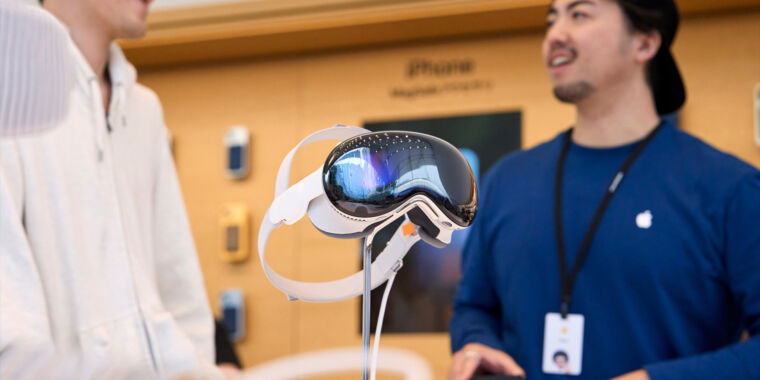Apple overhauls MacBook Pro lineup with M3 chips and a new entry-level option
-
Apple leans into its event’s spooky vibes with the new space black version of the MacBook Pro.
Apple -
The MacBook Pro.
Apple -
The exterior design remains largely unchanged from the previous Apple Silicon MacBook Pros, new color aside.
Apple -
Compared to latter-day Intel MacBook Pros, the design has more rounded corners but a slightly chunkier and heavier frame.
Apple
NEW YORK—As expected, Apple has launched a newly refreshed lineup of 14- and 16-inch MacBook Pros at its “Scary Fast” product event this evening, replacing not just the last-generation versions of those laptops but also the old 13-inch MacBook Pro.
The company is accomplishing that last goal by introducing a less-expensive $1,599 version of the 14-inch MacBook Pro that uses a regular M3 chip instead of the M3 Pro or M3 Max.
Apple MacBook Pro 14inch and 16inch with M3
It isn’t as fast, it starts with a skimpy 8GB of RAM of storage, it has one fewer Thunderbolt port (for a total of two), and it only supports a single external display. But at $1,599, the M3 MacBook Pro is $400 cheaper than the M2 Pro/M3 Pro version of the laptop, and it still uses the larger high-refresh-rate ProMotion display, the contrast-boosting and bloom-reducing mini LED screen technology, the MagSafe connector, the 1080p camera, 512GB of storage in the base model, the speaker system, and a full-size HDMI port. Apple also quotes “up to 22 hours of battery life” for the M3 version, compared to “up to 18” for the M3 Pro and Max version.
The new MacBook Pros are all available for preorder today; the M3 and M3 Pro versions will be available starting November 7, and the M3 Max versions will be available “later in November.” The 14-inch Pro with an M3 Pro chip still starts at $1,999, while the 16-inch MacBook Pro with the M3 Pro chip still starts at $2,499.
| CPU P/E-cores | GPU cores | RAM options | Memory bandwidth | |
|---|---|---|---|---|
| M3 (entry-level) | 4P/4E | 8 | 8/16/24GB | 100GB/s |
| M3 | 4P/4E | 10 | 8/16/24GB | 100GB/s |
| M3 Pro (entry-level) | 5P/6E | 14 | 18/36GB | 150GB/s |
| M3 Pro | 6P/6E | 18 | 18/36GB | 150GB/s |
| M3 Max (entry-level) | 10P/4E | 30 | 36/96GB | 300GB/s |
| M3 Max | 12P/4E | 40 | 48/64/128GB | 400GB/s |
We’ve gone into the M3 chip updates in greater detail in a separate post. Compared to the M2 Pro and M2 Max versions, the most important thing to know is that the M3 Pro is a small step down in core counts from the M2 Pro—the M2 Pro had eight high-performance CPU cores and four high-efficiency cores, while the M3 Pro has six of each; M3 Pro’s GPU also tops out at 18 cores, down from 19 in the M2 Pro. The maximum amount of RAM goes up a little, from 32GB to 36GB, and we’d still expect the updated architecture and the 3 nm manufacturing process to result in a net speed gain compared to the M2 Pro. But it may not be as large as the jump that the M3 Max gets.
The M3 Max is a significantly larger chip than the M2 Max, going from eight performance cores and four efficiency cores to 12 performance cores and four efficiency cores. The maximum GPU core count increases from 38 to 40, and the maximum amount of RAM goes up from 96GB to 128GB. You’ll pay quite a bit for that privilege, though—$300 to pay for the (required) upgrade to a fully enabled M3 Max, and another $1,200 for the actual 128GB memory upgrade, bringing the total cost of the system to at least $4,699 before considering storage or other additions. Choosing the Max chip also gets you four external displays, up from two for the M3 Pro and one for the M3, plus a second ProRes video encoding and decoding engine.
All the M3 MacBook Pros support new M3 family features like hardware-accelerated ray-tracing and hardware-accelerated AV1 video decoding support.
Apple
Aside from specs, there are just a couple of noteworthy changes to the exterior. A new space black color option for the M3 Pro and M3 Max versions of the laptop looks a lot like the version Apple shipped with the M2 MacBook Air but with changes to the anodization process that keep it from picking up fingerprints as easily as the black versions of the MacBook Air do. Thanks to a brief hands-on session with the system, we can confirm that the new coating gets way less fingerprint-y than the Air does; although, to my eyes, it also looked slightly less black.
The M3 MacBook Pro only comes in silver or space gray; the M3 Pro and M3 Max versions come in silver and space black but not space gray. Tints of actual color remain frustratingly absent, confined to iMacs, iPhones, and some flavors of iPad.
The screen on the new MacBook Pros also improves modestly, increasing the brightness of SDR content from 500 to 600 nits. Sustained and peak HDR brightness remains unchanged, at 1,000 and 1,600 nits, respectively.
These new MacBook Pros are coming out just 10 months after the M2 models that Apple announced in January. That’s apparently because the M2 Pros were introduced a couple of months later than intended. But even if they had launched in October 2022, the M3 MacBook Pros would be getting replaced more quickly than the M2 MacBook Air, which was originally released in July 2022. Because of its still-young 3 nm manufacturing process, it’s possible that the M3 isn’t being made in enough volume to satisfy a new MacBook Air’s worth of demand; in any case, an update in the winter or spring seems probable.
Listing image by Apple














Post Comment